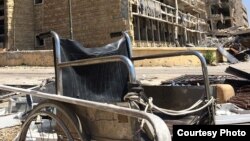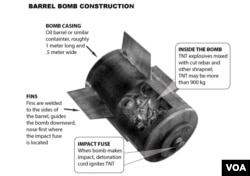The explosives are crude, made of heavy steel wire, even nuts and bolts packed into oil drums or water tanks. Known as barrel bombs, they’re devastating whenever Syrian government forces drop them on civilian populations.
What happens next is even more insidious, said Zaher Sahloul, a Syrian-born, Chicago-based emergency doctor.
“Usually the first barrel bombs fall, then people gather to pull victims out from under the rubble, the medics come and doctors start to work, then there is another second, even third bomb,” he said.
This is the state of war in Syria, now in its fifth grinding year, where there are no frontlines, where civilians are targeted with impunity, and where the laws of armed conflict don’t exist.
It’s a conclusion backed up by a harrowing new report, Syrian Medical Voices from the Ground: The Ordeal of Syria’s Healthcare Professionals, which offers a “ground-level view” of the daily struggle of physicians and nurses attempting triage while being targeted themselves.
The report was compiled by the organization Sahloul heads, the Syrian American Medical Society, in collaboration with the Johns Hopkins Center for Public Health and Human Rights. Researchers interviewed 27 medical personnel working on the ground in Aleppo, Idlib and other besieged areas.
The health care system in opposition-held areas has been destroyed. Many health care workers have fled the country.
For those health care workers who remain, the situation is “unimaginable,” Sahloul said, made worse by the constant threat of barrel bombs.
More than 600 health care workers have been killed, according to Physicians for Human Rights, and more than 230 medical facilities have been deliberately attacked since 2011.
“And these are underestimates,” Sahloul told VOA. “Every day we hear about a physician or nurse who has been killed.”
Others have been arrested, detained and tortured in government prisons.
Syrian activists estimate more than 210,000 people have died since 2011 when an antigovernment uprising began, with nearly half of the deaths civilians.
Maximum harm, minimal cost
The barrel bombs are made from oil drums or water tanks that are packed with explosives or flammable substances and assorted shrapnel—bits of heavy steel wire, even nuts and bolts. Sometimes they also are filled with chemicals.
They are cheap to make—about $200 apiece—and easily delivered by helicopter: a cost-effective way to terrorize the population.
Syrian President Bashar al-Assad has denied their use in a February interview with the BBC. But Sahloul and human rights groups say only the Assad regime has the helicopters to drop them.
“I’ve seen the impact of barrel bombs just four weeks ago,” he said. “And I’ve seen it in every medical mission. Each bomb will destroy half a block or a whole block, depending on how much TNT is stuffed into these oil drums.”
Watch raw video of barrel bomb attacks:
One doctor reported having to treat a patient injured by shrapnel the size of a human hand. Another doctor described a mother and daughter who had been blown apart by the impact of a barrel bomb, but their hands remained locked in death.
Doctors are frequently forced to make heart-rending decisions about who they can help and who they cannot.
“If an operation is likely to take more than two hours, we have to forget it, and the patient dies,” the report quotes one unnamed doctor as saying.
“Some dentists and nurses in some areas of Syria have to perform surgery, because they are the only health care professionals in town,” Sahloul said. “Sometimes they have to open abdomens. Sometimes they have to deal with fractures. Sometimes they have to do amputations.”
To avoid attack, doctors and nurses set up field hospitals in unlikely locations – former factories, chicken houses, even caves.
They often lack basic supplies, medicine and testing equipment. Sahloul’s organization has donated more than $6 million in equipment and supplies to Syrian medical workers. It has trained nearly 500 doctors in emergency medicine and disaster management.
“When you see children who have spinal cord injuries or have sustained burns because of these bombings, and when you see children who are not able to smile because of the psycho-social trauma, it impacts you as a physician, as a nurse,” he said.
The report called for the international community to pressure Assad’s government to stop using barrel bombs. They also called for creation of a safe zone in northern Syria for civilians escaping attacks and seeking health care, education and humanitarian aid.









